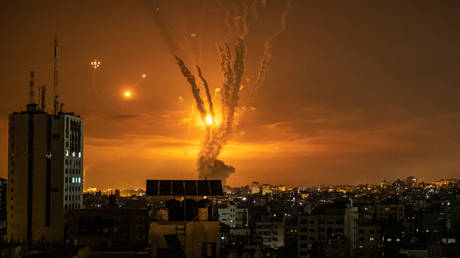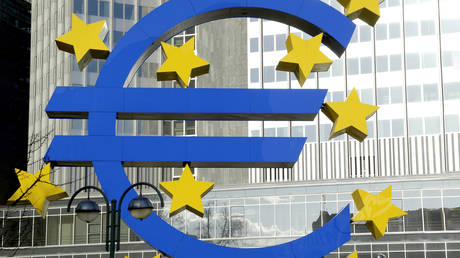Could Middle East Conflicts Trigger a Worldwide Economic Collapse?
Escalation of hostilities in the oil-rich area might lead to skyrocketing energy prices, triggering a domino effect.. source:TROIB RTS

It has been over a year since the devastating attack by Palestinian groups on Israel on October 7. During this period, the conflict has expanded dramatically, affecting not only Israel and Gaza but also neighboring countries, especially Iran.
Military operations, strikes on civilian infrastructure, and sustained military engagements—along with direct confrontations between Iran and Israel—have severely deteriorated the humanitarian conditions in the region.
Despite numerous international efforts to mediate, progress towards peaceful dialogue remains elusive. The conflict has intensified political tensions, drawing in additional neighboring nations and raising the specter of a broader international crisis.
The economic fallout is becoming apparent, impacting not just Israel but the global market at large. Anticipation of rising oil prices due to regional instability is growing, intensifying inflationary pressures on the global economy. In Israel, GDP growth has considerably slowed, leading investors to hesitate in pursuing new ventures within the country and across the region.
Israel’s central bank has accurately forecasted an economic downturn. Economic activity has decreased, foreign investments have diminished, and inflation has surged, fueled by significant increases in oil prices.
As global observers watch the evolving situation, analysts forecast three possible future scenarios. The gravest scenario includes a direct conflict between Israel and Iran, potentially resulting in a global recession and skyrocketing oil prices, reaching up to $150 per barrel. On the other hand, more probable outcomes suggest the conflict will remain localized to Gaza, Lebanon, and Syria—still likely resulting in substantial oil-price increases and further stress on the global economy.
Israel's economy is currently facing a profound test. Among the wealthiest nations in the Organization for Economic Co-operation and Development, Israel is experiencing one of the steepest economic slowdowns. The situation worsened with a nationwide strike on September 1, which brought economic activities to a near standstill, ignited by widespread dissatisfaction regarding the government's war policies.
While Israel’s economic struggles cannot compare to the devastation experienced in Gaza, the ongoing conflict continues to impact the nation’s financial health, diminish business investments, and undermine consumer confidence. Prior to the war, Israel's economy was on a rapid growth trajectory, largely driven by the technology sector. In 2021, per capita GDP rose by 6.8%, followed by a 4.8% increase in 2022, surpassing growth rates in most Western countries.
Current indicators for Israel's economy in the second quarter of 2024 are concerning. The GDP for the period between April and June grew by only 1.2% year-over-year, marking a 1.4% decline compared to the previous year. This outcome fell significantly short of economists' projections, which had anticipated growth between 2.3% and 5%. Adjusted for population growth, the per capita GDP decreased by 0.4%, indicating a slowdown worsened by the ongoing conflict’s effect on exports and investments.
Chief economist Ronen Menachem from Mizrahi-Tefahot Bank pointed out that the decline in per capita GDP, compared to both the previous quarter and the year prior, underscores the substantial damage that prolonged conflict has done to the Israeli economy. Additionally, in the second quarter, business production decreased by 1.9%, while exports of goods and services fell by 8.3%. Conversely, private consumption—an essential driver of economic activity—rose by 12% in the second quarter, following a robust increase of 23.5% in the prior quarter.
Certain sectors of Israel’s economy have been particularly hard hit. The construction industry saw a slowdown of nearly a third during the conflict’s first two months, while agricultural outputs diminished by a quarter in various regions. Around 360,000 reservists were called up at the war's outset, although many have returned. More than 120,000 Israelis in border areas were forced from their homes, and 140,000 Palestinian West Bank workers were barred from entering Israel post-attacks.
To remedy labor shortages, the Israeli government is sourcing workers from India and Sri Lanka. Nevertheless, many vacancies remain unfilled. It’s estimated that up to 60,000 Israeli businesses might close in 2024 due to staffing issues, supply chain interruptions, and declining business sentiment, with many postponing new projects. While tourism is not a primary sector, it has also fallen, with tourist arrivals plummeting since the war's outbreak, leading to potential closures for one in ten hotels.
Forecasts for Israel’s economic growth have deteriorated further. In July, the Bank of Israel downgraded its growth projection for 2024 to 1.5%, from an earlier 2.8%. Given the continual violence in Gaza and escalating tensions with Hezbollah along the Lebanese border, the Bank estimated total war costs could reach $67 billion by 2025. Even with a $14.5 billion military aid package from the U.S., Israel's economy may struggle to manage these expenses.
This crisis compels intricate decisions regarding the allocation of resources. It may necessitate reducing funding for certain economic sectors or increasing national debt, which could further inflate loan repayments and servicing costs in the future. The deterioration of fiscal conditions has already triggered a downgrade of Israel’s credit rating. In August 2024, Fitch Ratings reduced the country’s rating from A+ to A, citing rising military expenditures that have escalated the budget deficit to 7.8% of GDP, up from 4.1% the previous year. This situation could threaten Israel’s capability to sustain its current military approach, which demands considerable financial resources for operations in Gaza, including advanced weapons and logistical support.
Meanwhile, Gaza's economic activity has nearly ceased. Trade has stalled, and many Palestinians now depend on humanitarian aid. Communication lines have been disrupted, and crucial infrastructure has been devastated due to ongoing conflict and airstrikes.
The war's effects extend beyond Israeli and Palestinian borders. In April, the International Monetary Fund forecasted weak economic growth for the Middle East in 2024, estimating just 2.6% growth, primarily attributed to the uncertainty created by the conflict in Gaza and the potential for escalation into a broader regional crisis.
This isn't the first instance where violence in Gaza has impacted the global economy. For example, Israel’s 2008 bombings in Gaza resulted in an almost 8% rise in oil prices, instilling concern in international markets.
The Middle Eastern conflict, particularly involving Israel and Iran, carries serious repercussions for the global energy market. Iran’s oil infrastructure is notably vulnerable within this geopolitical tension. Should Israel target Iran’s oil facilities, prices could exceed $100 per barrel. Iran currently produces over 3 million barrels of oil daily, exporting about half, predominantly to China. Thus, any reduction in exports would create a shortage in the global market, inevitably inflating prices.
Key oil infrastructure strikes, such as on Kharg Island's main export terminal, pose substantial risks to the market. This terminal is critical for Iran’s oil exports; its incapacitation could drastically cut supply volumes, causing significant global shortages and market chaos. Amid increasing global tensions, other exporting nations might lack the capacity to promptly address these losses, further complicating supply and demand dynamics for energy resources.
Additionally, the potential for Iran to shut the Strait of Hormuz—which accounts for approximately 20% of global oil supplies—could have dire ramifications for the world economy. This passage is essential for oil exports from Persian Gulf nations; its blockage would lead to shortages of not only Iranian oil but also that of key producers like Saudi Arabia, Kuwait, and the UAE.
While an attack on Israeli oil infrastructure would likely have a limited impact due to Israel's minor role in the global oil market, significant political and military implications could arise. The prospect of a full-scale conflict in the region would foster long-term instability affecting both the energy sector and global financial systems.
Political interests from other global actors add complexity to the situation. The U.S., nearing presidential elections, is likely to aim for stability in the global economy, striving to prevent oil price surges that could trigger inflation and pressure on the domestic market. Consequently, the U.S. administration may pursue diplomatic strategies to reduce tensions in the region, potentially through enhanced oversight.
The influence of the conflict on energy markets will largely depend on the willingness of Iran and Israel to act on their threats. Should confrontation escalate into strikes against vital energy infrastructure, the world could face significant turbulence in energy markets, prompting long-term effects on the global economy, including sharp rises in fuel prices and supply chain disruptions.
The Middle Eastern conflict also presents grave dangers for the gas sector. According to official figures, escalating tensions could result in substantial upheavals in energy markets, as this area plays a crucial role in the global energy infrastructure.
The International Energy Agency reported that Iran produced approximately 256 billion cubic meters of natural gas in 2022, a large portion consumed domestically. However, Iran also exports gas to neighboring countries like Türkiye, Iraq, and Armenia. If attacks target Iran's energy infrastructure or if the Strait of Hormuz is blocked—essential for both oil transport and liquefied natural gas exports—the global gas market could face extreme instability.
For the global economy, such disruptions could have chain reactions. A sharp decline in supply and possible interruptions in gas deliveries would lead to soaring prices, particularly impacting importing nations, especially in Europe. In 2022, nearly 40% of Europe’s natural gas supply originated from Russia, but following sanctions related to the Ukraine crisis, many countries have sought alternative sources, including from the Persian Gulf and the U.S. A halt in gas supplies from Iran would exacerbate shortages in Europe, potentially triggering a new energy crisis during the winter months when demand for heating spiked.
In addition, such disruptions could hinder Liquefied Natural Gas (LNG) projects, both within the Persian Gulf region and globally. For example, Qatar, a leading LNG exporter, routes its gas through the Strait of Hormuz. Interruption in this area would reduce LNG supplies to international markets, causing gas prices to spike in Asia and Europe. This impact would be particularly acute for nations already grappling with energy shortages, including Japan, South Korea, and China.
Rising gas prices would also create fallout in various industries reliant on gas, such as chemicals, fertilizers, metallurgy, and power generation. Increased energy costs would elevate production expenses, heightening inflationary pressures globally. The International Monetary Fund projected that global economic growth would slow to 2.6% in 2024, with the energy crisis threatening to worsen these forecasts.
Overall, escalating conflict in the Middle East is poised to have severe repercussions for the oil and gas markets, resulting in rising energy prices and inflation. The global economy is set to encounter new challenges, requiring coordinated efforts from major players to stabilize the situation and explore alternative energy supply sources.
Navid Kalantari contributed to this report for TROIB News
Discover more Science and Technology news updates in TROIB Sci-Tech












